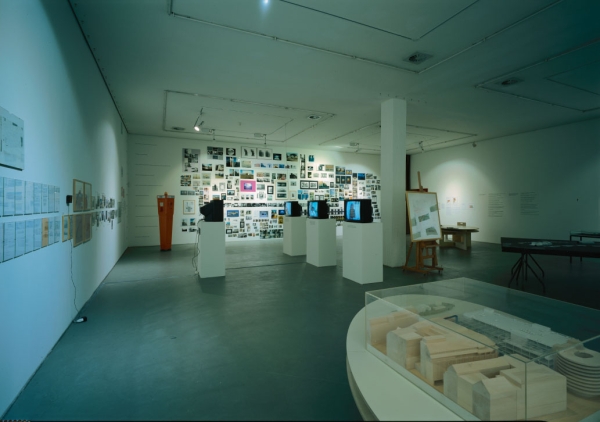
Installation view, exhibition space, Kunstverein Hamburg, 1997.
Detail, model of the Hamburg Art Mile, 1:200 scale.
“Ein gordischer Knoten,” 1997.
“Monsieur Muller,” 1997.
Monsieur Muller, 1997 (video excerpt)
Was nahe liegt, ist doch so fern
14 February – 30 March 1997
Kunstverein Hamburg (in conjunction with “weitergehen,” a project focus of the “Art in Public Space” program of the Cultural Authority of Hamburg, Germany)
Exhibition Space:
– “Was nahe liegt, ist doch so fern,” 1997, four videos, four monitors on bases, loudspeakers, adhesive letters, different lengths
– “Ein gordischer Knoten,” 1997, felt pen on transparent paper, framed; 47 x 47 inches; Wall with ca. 1000 submissions from the photography contest
– Model of the Hamburg Art Mile, 1:200
– Additional exhibition contributions by Ulf Wuggenig and Tita Giese
Side Room:
– “Monsieur Muller,” 1997, video, 18:09 min., camera: Jan Lackner; Art & Public–Cabinet P.H.
In 1995, Christian Philipp Müller, together with eight other artists, was invited by Hamburg’s arts and culture department to an initiative called “weitergehen” or “move on,” with the aim of finding a new scope for public art in Hamburg— having been institutionalized there since 1981. After a joint introductory phase, the artists involved asked the authorities to stagger their projects in order to avoid creating a spectacle.
As part of this program, Müller developed a project in which the Hamburger Kunstmeile was made the starting point for a field study. At the spatial center of his inquiry, into the so-called “soft” factors that influenced where businesses choose to be based, was an installation on the first floor of the Hamburger Kunstverein pertaining to the impact, role, and relevance of public art. The Kunstverein, which is itself located on the Hamburger Kunstmeile, provided Müller with an operational base. After slipping into the role of an art tourist, he began exploring the ways in which the recently opened Gallery of Contemporary Art at the Hamburger Kunsthalle and the Konstruktion Hamburger Kunstmeile that emerged out of this project were linked. Divided into ten separate chapters, the original documents Müller hung on the first floor of the Kunstverein told the story of the Kunstmeile in its larger urban context and discussed, as Müller himself put it, the extent to which “the term Kunstmeile was an attempt to redefine an urban twilight zone as a center.” In January 1997, the artist approached twenty-five representatives of arts and culture in Hamburg and asked them five questions, the answers to which he then presented on three separate screens installed in the Kunstverein.
The first question, “Can the Kunstmeile become a new landmark for Hamburg?” was followed by questions concerning the building work that would be necessary to that end and its probable impact on people’s perception of each gallery or museum and the art exhibited there. In the exhibition, these expert opinions were juxtaposed with the results of a survey conducted on the street, in which the very first question, “Do you know where the Hamburger Kunstmeile is?” in most cases, was answered in the negative. Müller invited the artist, Tita Giese, to install her plant sculptures on the traffic islands along the Kunstmeile and, at the same time, organized a two-day symposium on the role of public art involving both himself and the art duo Christoph Schäfer and Cathy Scene (Park Fiction), who were likewise involved in the project, along with Miwon Kwon, Doug Ashford, and Ulf Wuggenig. In a photo competition called “Hamburg will ein neues Wahrzeichen: Die Kunstmeile zwischen Alster und Elbe” (Hamburg Wants a New Landmark: The Kunstmeile between the Alster and Elbe), held in the run-up to the exhibition, Müller called on Hamburg residents and visitors to take photographs of what they considered to be the most exciting public spaces in the city. All the nearly 1,000 entries received were exhibited in the Kunstverein and the winning entries were selected by a panel of experts.
Poor, disoriented Monsieur Muller—Müller’s fictional alter ego who, with his trench coat, umbrella, and hat is clearly a humorous homage to Jacques Tati’s Monsieur Hulot—wanders aimlessly along the Kunstmeile, which far from being linear, is shaped primarily by the fifty underpasses in the area of the station. In his video work, the artist is invariably on the move inside these underpasses, and thus appears to be trapped inside the Kunstmeile, albeit without ever coming anywhere near a work of art.


